This article was originally written for Cheap
and Sleazy in October, 2009. It has been slightly revised
for this page.
From the Trenches of the Ivory Tower:
A Day in the Life of an Academic CART Provider
When Glen asked me to write this article, he wanted me to say a little
something about how I got into CART and what steno students should do
if they're interested in pursuing it. Then I unwittingly foiled his plan
by uploading two articles to my website that I'd been working on,
which essentially answered those same questions: How I Got Out of Steno
School and Is CART
Easier than Court Reporting?. I didn't want to repeat myself,
so I figured that the best way to fulfill his commission would be
to lead readers through an average day on the job.
6:50 -- The alarm goes off. I drag myself out of bed and into the
shower. Freshly scrubbed and moderately more awake, I open my closet
and dig through my laundry for a black t-shirt and black slacks.
The majority of CART providers who work in universities usually
dress to fit in with the other college students, but I like
having a uniform. All black is what ASL interpreters traditionally
wear, and it keeps me from having to agonize over my clothes
when I'm still staggering blearily around in the morning.
7:10 -- I'm on the subway, heading downtown. This semester the
majority of my classes are for two students at a university in Brooklyn,
though I also have two classes for a student at a university in
Manhattan. I get a seat after half a dozen stops or so and pull out my
RPR workbook to study for the written knowledge test I'm taking later
this week. Unlike most court reporters, I decided to make passing the
CCP a priority before tackling the non-realtime tests. I passed it last May,
so now I'm hoping to pass the RPR so I can qualify to take the RMR.
If I could take a higher-speed (nonlegal) realtime test, I'd go for that instead,
but the RMR is the fastest skills test currently offered by the NCRA,
so it's what I'm aiming for at the moment.
 Brooklyn in the morning.
Brooklyn in the morning.
8:10 -- I get off the train in Brooklyn and head for the office space
I'm renting. In previous semesters (I'm starting my third year of
providing CART full time) I'd been granted access to various
universities' wireless networks, but the disability office at the
university I'm working at this year wasn't able to get me an account.
Fortunately I've found a building just a block away that offers
coworking space with wireless internet and all the coffee I can drink for
a low monthly fee -- low for NYC, anyway. I was pretty diligent
the day before, so I don't have to edit any last-minute transcripts,
but I pour myself some coffee and do a little more RPR studying
until about 25 minutes before class starts. Then I amble over
to the university and set up all my equipment before the other
students start filing in. I try to be ready to go 15 minutes
before each class, just to allow for any logistical contingency.
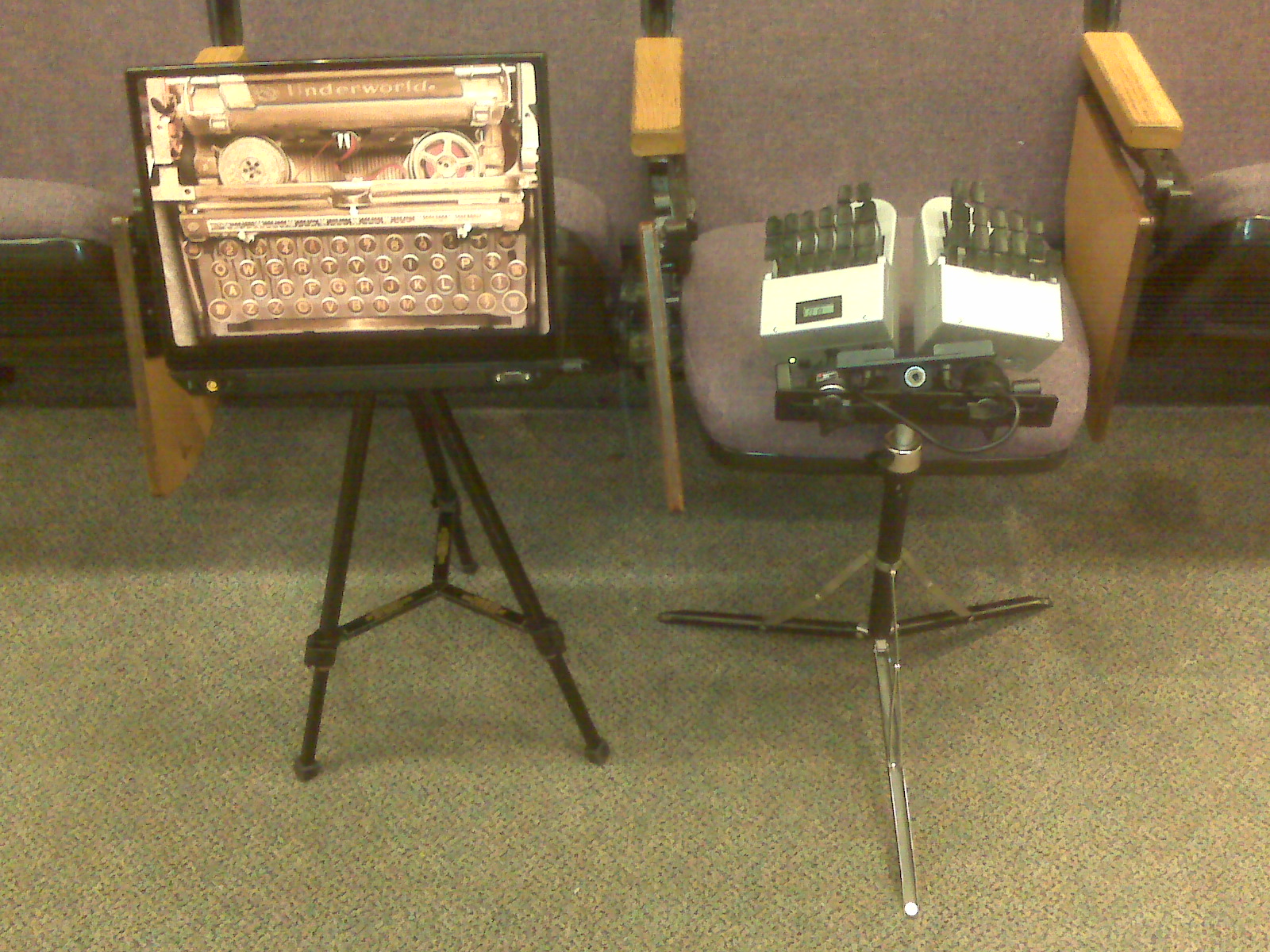 My setup in the classroom. The student sits directly behind the
computer, in the second row.
My setup in the classroom. The student sits directly behind the
computer, in the second row.
8:55 -- The student I'm CARTing for comes in. He's in his fifth year
of pharmacy school, and this is my third semester of providing CART
for his lecture classes. I sign, "Hey! How are you?" in ASL.
"Fine," he signs back. He has a cochlear implant and prefers ASL
interpreters for his lab and discussion classes, but he likes CART
for lectures because there's so much high-speed technical terminology
that's difficult for the interpreters to fingerspell. Five minutes later
the professor walks in, and it's off to the races.
11:00 -- The first two classes of the day are done,
so I pack everything into my backpack and buy a sandwich
on the way to my office space. Over breakfast I edit the morning's
transcripts. They were pretty clean, so it doesn't take long. All my
transcripts go through three passes before I send them off. First I
scan for my flag stroke (I use PHO*EUFP). I have it defined as {NULL},
which makes it invisible, but I write it whenever I notice an error --
in word boundaries, spelling, translation, or capitalization -- that I'm
not able to fix on the fly. I correct those, then go back up to the
top and scan for words translated phonetically or guessed
by Translation Magic. Sometimes these go in my dictionary as is,
and sometimes I need to redefine them. Finally I export the
file into .txt format and open it in Vim. I run spellcheck,
googling words I'm not sure of by highlighting them and pressing Alt-9.
When I've fixed everything, I email the transcripts to the student
and head back to the university at 11:35 for the next block of classes.
12:00 -- The noon class is always the hardest, and I have to
concentrate intently on both the professor and the PowerPoint slides
to make sure I get everything. If I get the handouts ahead of time,
I'll enter all the new words into my dictionary, making up
brief forms as I go for long words and phrases such as
"equilibrium" (HRAOERPL) and "glomerular filtration rate" (GHR-*FR).
When something comes up that I haven't been able to enter in advance,
I use my custom Eclipse macros to make globals from my writer.
Since I've been at this for a while, I've got two pretty good medical
dictionaries built up: One pharmacological, with 3,699 entries, and
one ophthalmological, with 651 entries; all on top of my general
dictionary, which is 117,338 entries.
It took a lot of effort to get there. When I first started
providing CART at this university, I spent hours entering in every
drug name, disease state, prefix/suffix (469 of those in my
pharmacological dictionary and counting) -- both stroking them out
phonetically and making up brief forms for fast-paced lectures
where they came up a lot. For example, Rituximab is in there
both as REU/TUBGS/PHAB and as RUBGS/MAB. Glucuronidation
is in there as TKPWHRAOUBG/ROPB/TKAEUGS and TKPWHRA*EURBGS. Usually
I enter the phonetic version first, then after I've had to stroke it
out a few times and I know it'll be coming up again, I think of
a nice time-saving brief for it.
For ease of making definitions during class I've set the globaling
window to transparent, made it tiny, and put it in the upper right
hand corner of the screen, so the student doesn't even notice when
it pops up while correcting errors and making new dictionary entries.
I also do a lot of spot correction whenever the professor
stops for breath, moving the cursor around the transcript
and toggling hyperkeys on and off to delete errors
and replace them with what was really said. Fortunately I've got
"follow always" selected, so as soon as the professor starts
speaking again, I just have to start writing normally and the cursor
jumps back down to the bottom of the transcript by itself. The
noon class lasts two hours, then there's an hour-long class, and then
I get a three and a half hour break.
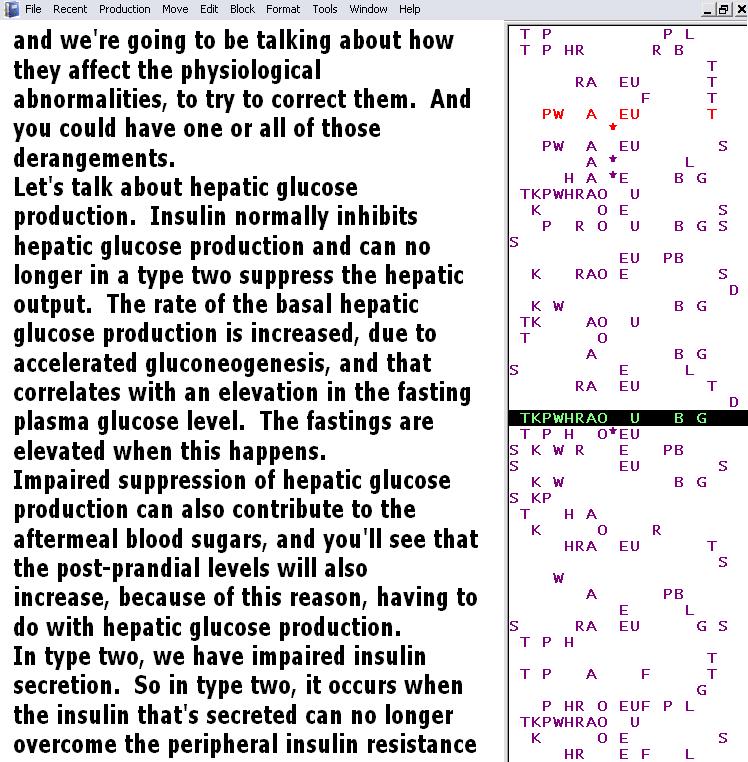 This is a screenshot of the editing process, not the CART
window. When providing CART, be sure to hide the notebar and
customize the font size according to the client's preferences.
This is a screenshot of the editing process, not the CART
window. When providing CART, be sure to hide the notebar and
customize the font size according to the client's preferences.
3:00 -- To the office once more, to edit the afternoon's two
transcripts, do any necessary prep work for upcoming classes, spend a
little time practicing with Realtime Coach, maybe
read one of the chapters in my Academy of Hearing Loss
Support Specialists self-paced certificate course (both useful
in its own right and for completing the CEU requirement of
my CCP certification) or take care of any transcription work
I've got pending. Like many CART providers, I'm usually not able
to secure steady CART work over the summer semester, but unlike
most of them I don't have any training in court reporting,
so I can't just go do deposition work. I usually fall back
on general transcription for focus groups and research studies.
Usually I drop it all once the fall CART season starts again,
but recently I managed to find a transcription client I enjoy
working with so much that I decided to keep them year-round;
they're a company that publishes articles on ophthalmology,
and I'm always eager to add new medical words to my
dictionary, so I consider it steno practice as well
as a little extra cash to be made in my spare time.
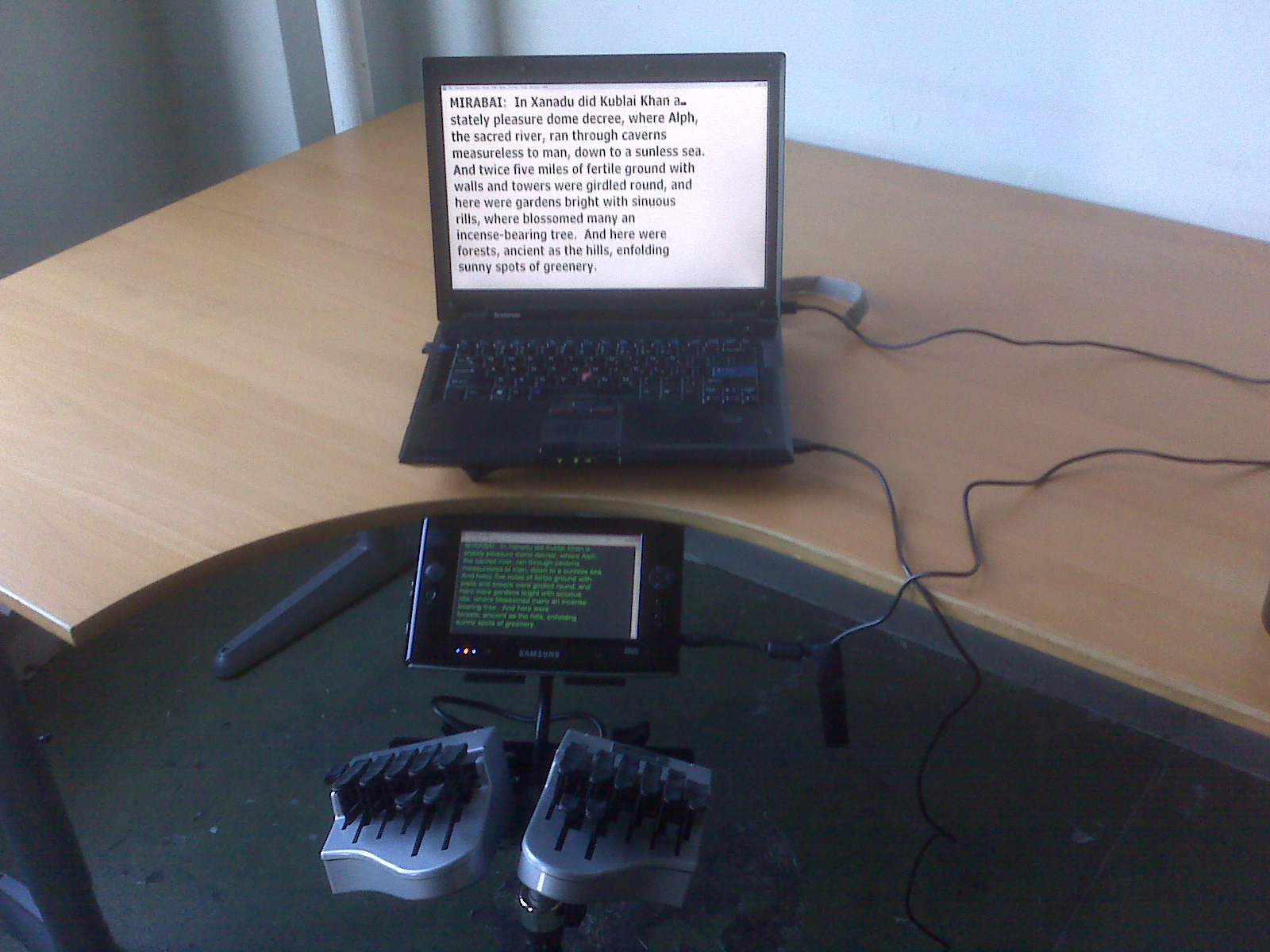
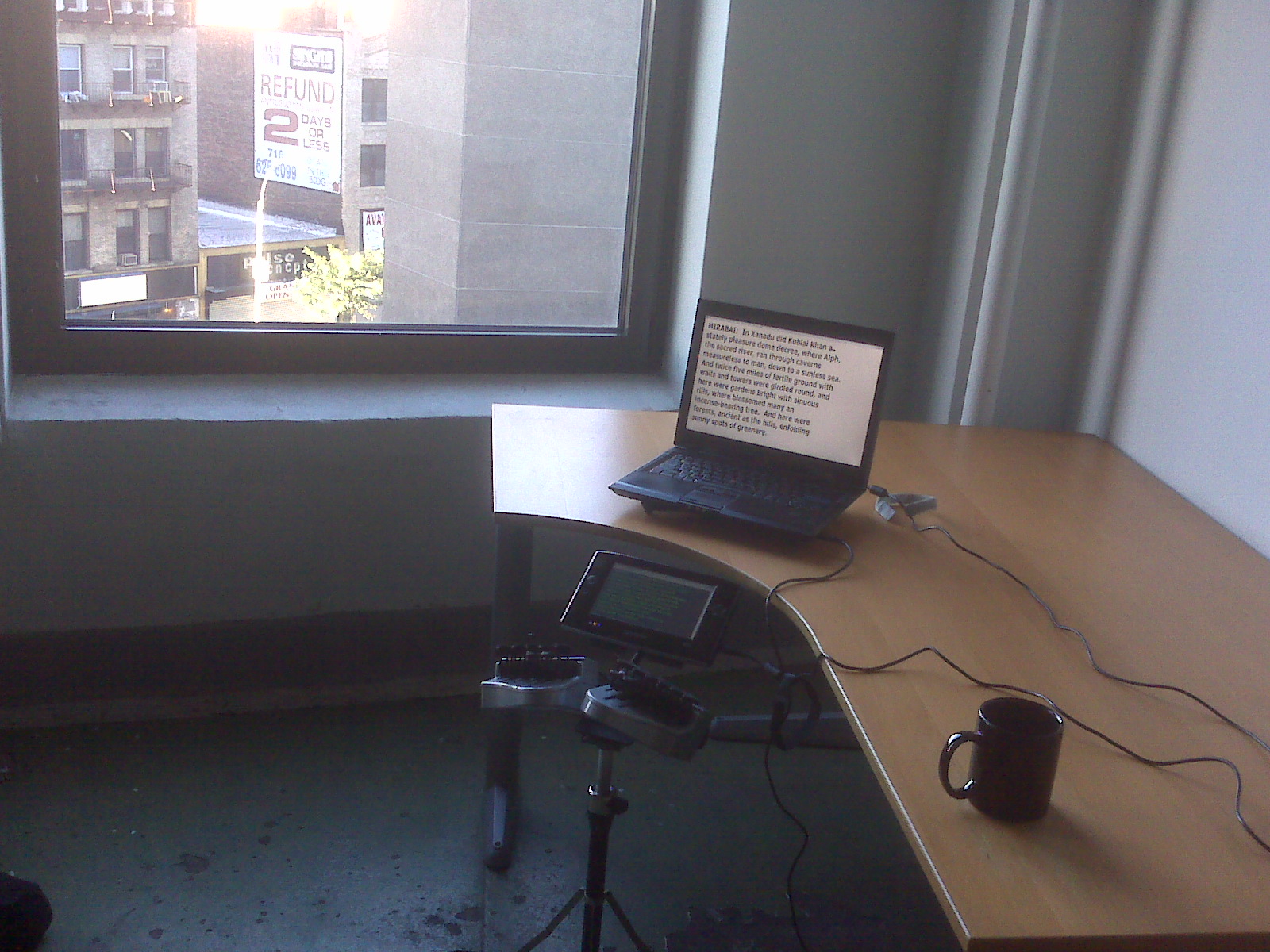 I don't usually use my Samsung Q1 when I'm transcribing, but
I wanted to show it off, and I'm not using it in the
classroom today; it mostly comes in handy for classes
with a lot of moving around.
I don't usually use my Samsung Q1 when I'm transcribing, but
I wanted to show it off, and I'm not using it in the
classroom today; it mostly comes in handy for classes
with a lot of moving around.
5:00 -- I finish transcribing the ophthalmology interview,
edit it, and send it off. Next up is checking in on my Twitter feed,
Google Ad results, and website maintenance. The next time the slow
months come around, my goal is to make it through on CART rather
than transcription. I've definitely been getting more per diem jobs
lately, as I've begun to get my name out -- though I want semester-long
academic classes to continue being my bread and butter during the
school year. Last summer I got the chance to provide CART for a disability
conference which kicked off with a live speech by the Mayor of NYC.
That was probably as nervous as I've ever been in front of a steno machine,
but I carried it off all right, and each successful job has brought in new work
by word of mouth. Reputation isn't everything, though. Later in the summer
an organization found me via my website and asked me to provide CART
for two sessions of a disability conference at the United Nations.
A healthy web presence is one of the best ways to find work
as a freelancer these days. I sketch out some ways to expand my site
and read up on the latest steno news going around the internet.
Finally I've done about all I need to do in my workspace,
so I put my gear away away and head out for a quick bite
from the gyro cart before my evening class.
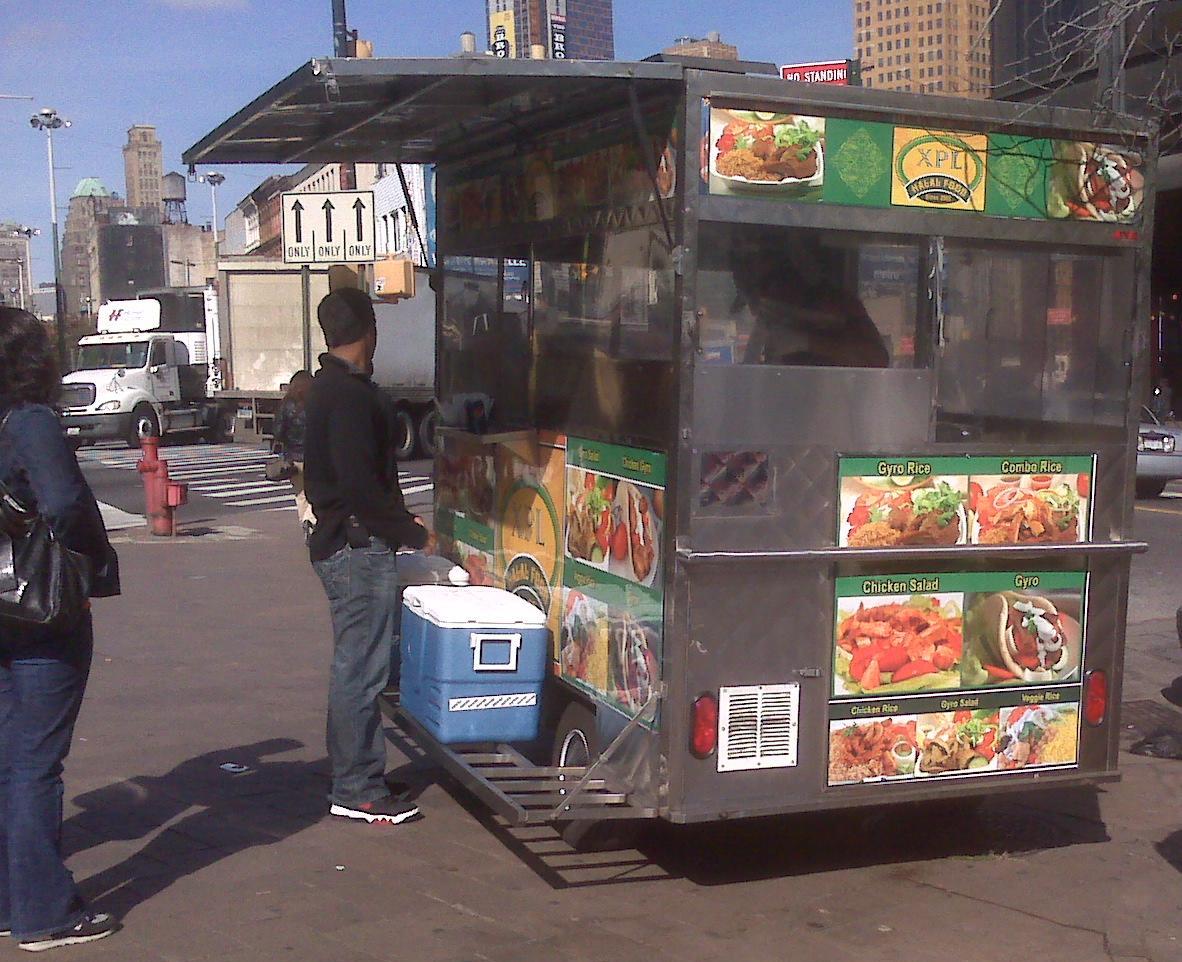 A more delicious kind of cart.
A more delicious kind of cart.
6:30 -- Last class of the evening, for a graduate student getting her
MFA in poetry. The infinite diversity of classes I get to transcribe
is my absolute favorite part of the job. I've done everything from Tax
Law to Urban Planning to Architecture to Sociology. My ultimate goal
is to CART a Deaf or hard of hearing student through medical school (Another reason to
hope Michael
Argenyi wins his case and establishes a national precedent),
which is why I like the ophthalmology and pharmacy work so much, with
the literature classes coming a close second. Part of what makes
this job great, though, is that I'm always winding up in the middle
of classes for fields I'd barely heard of, had never thought to study,
and wind up learning a fair bit about. It's the best thing in the galaxy
for a dilettante like me. I feel ridiculously lucky as I pack up my gear
and head to the subway around 9:15. I usually get a seat at that hour,
so I do a little transcript editing or studying during the trip.
Edit as of 2013: All that ophthalmology and pharmacy work paid off! I've CARTed for two medical students and a dental student since then, and the experience has been just as challenging and fascinating as I'd hoped. I've also passed the RMR and am waiting to take my RDR written examination.
10:20 -- Back at my apartment. I have a light dinner, send off
the last transcript, kiss my partner, feed my cat, and crash.
The next day...
6:50 -- Do it all again!
|
|
















































|

































































































